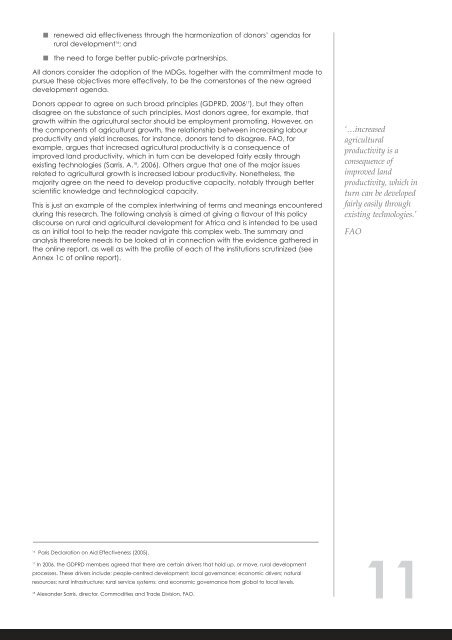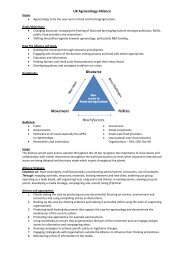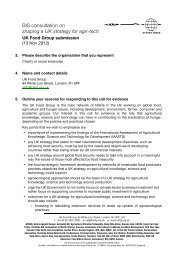More Aid for African Agriculture: policy options for ... - UK Food Group
More Aid for African Agriculture: policy options for ... - UK Food Group
More Aid for African Agriculture: policy options for ... - UK Food Group
Create successful ePaper yourself
Turn your PDF publications into a flip-book with our unique Google optimized e-Paper software.
■ renewed aid effectiveness through the harmonization of donors’ agendas <strong>for</strong><br />
rural development 16 ; and<br />
■ the need to <strong>for</strong>ge better public-private partnerships.<br />
All donors consider the adoption of the MDGs, together with the commitment made to<br />
pursue these objectives more effectively, to be the cornerstones of the new agreed<br />
development agenda.<br />
Donors appear to agree on such broad principles (GDPRD, 2006 17 ), but they often<br />
disagree on the substance of such principles. Most donors agree, <strong>for</strong> example, that<br />
growth within the agricultural sector should be employment promoting. However, on<br />
the components of agricultural growth, the relationship between increasing labour<br />
productivity and yield increases, <strong>for</strong> instance, donors tend to disagree. FAO, <strong>for</strong><br />
example, argues that increased agricultural productivity is a consequence of<br />
improved land productivity, which in turn can be developed fairly easily through<br />
existing technologies (Sarris, A. 18 , 2006). Others argue that one of the major issues<br />
related to agricultural growth is increased labour productivity. Nonetheless, the<br />
majority agree on the need to develop productive capacity, notably through better<br />
scientific knowledge and technological capacity.<br />
This is just an example of the complex intertwining of terms and meanings encountered<br />
during this research. The following analysis is aimed at giving a flavour of this <strong>policy</strong><br />
discourse on rural and agricultural development <strong>for</strong> Africa and is intended to be used<br />
as an initial tool to help the reader navigate this complex web. The summary and<br />
analysis there<strong>for</strong>e needs to be looked at in connection with the evidence gathered in<br />
the online report, as well as with the profile of each of the institutions scrutinized (see<br />
Annex 1c of online report).<br />
16 Paris Declaration on <strong>Aid</strong> Effectiveness (2005).<br />
17 In 2006, the GDPRD members agreed that there are certain drivers that hold up, or move, rural development<br />
processes. These drivers include: people-centred development; local governance; economic drivers; natural<br />
resources; rural infrastructure; rural service systems; and economic governance from global to local levels.<br />
18 Alexander Sarris, director, Commodities and Trade Division, FAO.<br />
‘…increased<br />
agricultural<br />
productivity is a<br />
consequence of<br />
improved land<br />
productivity, which in<br />
turn can be developed<br />
fairly easily through<br />
existing technologies.’<br />
FAO<br />
11





